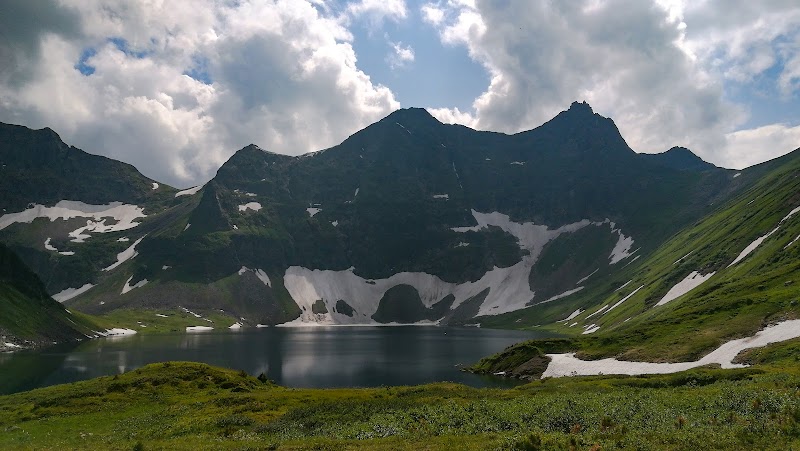Scaling the Stolby: A Practical Guide to Krasnoyarsk’s Towering Rock Pillars and Forest Vistas
Experience the thrill of hiking the Stolby Nature Sanctuary just outside Krasnoyarsk, where towering rock pillars emerge from dense Siberian forests. This guide offers practical insights and vivid descriptions to prepare you for an immersive adventure through rugged terrain and sweeping vistas.
Start Early to Beat Crowds and Heat
Begin your hike in the early morning to enjoy cooler temperatures and fewer visitors, making the experience more serene and safer on steep sections.
Wear Durable, Grippy Footwear
Choose hiking boots with good ankle support and deep treads to navigate slippery rocks and uneven forest trails confidently.
Carry Adequate Water
Though streams appear sporadically, it’s advisable to pack enough water for the entire hike to stay hydrated, especially in summer months.
Prepare for Variable Weather
Weather in Siberia can shift quickly—layer your clothing accordingly, and pack waterproof gear for sudden rain or wind on exposed plateaus.
Scaling the Stolby: A Practical Guide to Krasnoyarsk’s Towering Rock Pillars and Forest Vistas
Stretching across the Siberian wilderness just outside Krasnoyarsk, Stolby Nature Sanctuary challenges hikers to engage with a fierce wilderness that refuses to be tamed. This sprawling reserve is famous for its colossal rock pillars, some rising more than 100 meters, which thrust skyward like ancient guardians watching over dense pine and birch forests. The trail itself is a dynamic push and pull between steady forest paths and rugged rocky ascents. It’s a terrain that demands respect—the stones beneath your feet can be slippery after rain, and the steep climbs test your endurance while rewarding you with unmatched views.
Starting from the park’s official entrance, expect a hike of roughly 12 kilometers round trip. Elevation gain hovers around 500 meters, primarily during the ascent to key observation points such as the First and Second Stolby. The forest envelops you in quiet green, with pine needles cushioning your steps and occasional birds calling, daring you onward. Narrow ledges and rocky steps wind between towering weathered stone; here, the rock pillars seem almost like living entities, each bearing the marks of time and seasons.
Your pace will fluctuate. Some sections invite a steady rhythm through wooded trails, while others demand concentration as you maneuver boulders and scramble short vertical sections. Plan for roughly 4 to 5 hours to complete the loop comfortably, allowing time to pause and drink in panoramas that stretch over Krasnoyarsk and the Angara River below.
Hydration is key. Streams appear now and then, but it's safest to carry enough water for the full distance. Footwear with firm grip and ankle support will help with the uneven terrain, especially if trails are damp. Early morning starts are best to avoid midday heat in summer and to secure a quieter trail.
The sanctuary doesn’t just test your physical limits; it asks you to recognize its raw character. These rock towers and wooded slopes aren’t conquered. Instead, hikers join a conversation with a landscape steeped in Siberian spirit—rugged, resilient, and fiercely itself.
Nearby Trips
All Adventures
Boat Charters
Water Activities
Adventures near Krasnoyarsk
Discover the unique and memorable adventures that make Krasnoyarsk special.
Frequently Asked Questions
How difficult is the hike to Stolby’s main rock pillars?
The hike is moderate in difficulty, with about 12 kilometers round trip and elevation gain around 500 meters. It involves forest trails and rocky sections requiring some scrambling. Good fitness and stable footwear are advised.
Are there any facilities at Stolby Nature Sanctuary?
The sanctuary has marked trails and an official entrance area with basic amenities such as restrooms and information boards. However, food and water should be carried in as options inside the park are limited.
When is the best time to visit Stolby for hiking?
Late spring through early fall (May to September) offers the most favorable hiking conditions with less snow and moderate weather. Summer provides the longest daylight hours but be prepared for insects.
Is it safe to hike alone in Stolby Nature Sanctuary?
While many hikers go solo, it’s recommended to hike with a partner or group for safety, especially on rockier sections where slips can occur. Mobile signal may be weak in remote areas.
Can I climb the rock pillars at Stolby sanctuary?
Some pillars are popular with climbers, and designated routes exist for experienced climbers. For ordinary hikers, summits are reachable via marked trails and scrambling without technical climbing gear.
Are there any wildlife concerns while hiking in Stolby?
Hikers should be mindful of local wildlife like squirrels, woodpeckers, and occasional foxes. Bears are rare, but caution and noise-making are advised to avoid surprise encounters.
Recommended Gear
Hiking Boots
Sturdy boots with strong grip and ankle support protect your feet and improve stability on rocks and slippery forest paths.
Water Bottle or Hydration Pack
Bringing sufficient water is crucial as natural sources may not be reliable or easily accessible during the hike.
Layered Clothing
Layering helps adapt to fluctuating temperatures and sudden weather changes common in the region.
Insect Repellent
Keep mosquitoes and biting insects at bay during the warmer months for a more comfortable hike.
Local Insights
Hidden Gems
- "Viewpoint 'Eagle's Nest' offers a lesser-crowded perspective on the pillars and the Angara River beyond."
- "Small forest clearings near the southern boundary where wild berries often grow mid-summer."
Wildlife
- "Siberian Jay - a bold and curious bird often seen near the park entrances."
- "Eurasian Red Squirrel - lively and quick, frequently spotted darting across forest floors."
History
"The Stolby area holds cultural importance for the indigenous Evenki people and has long been a natural landmark documented since the 18th century, becoming a formal sanctuary in the 20th century to protect its unique rock formations and forest ecosystem."

